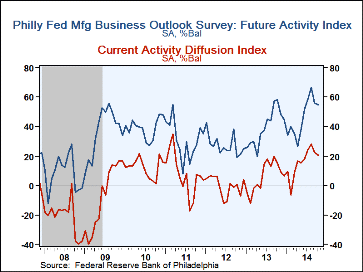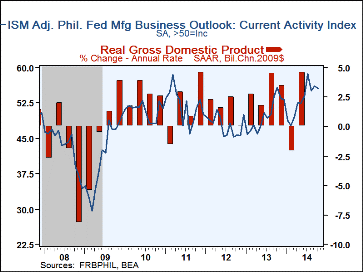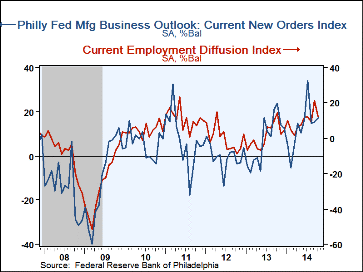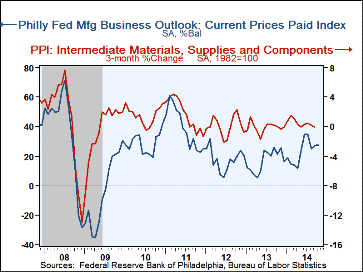 Global| Oct 16 2014
Global| Oct 16 2014Philadelphia Fed Business Conditions Index Declines Again
by:Tom Moeller
|in:Economy in Brief
Summary
The Philadelphia Federal Reserve Bank reported that its General Factory Sector Business Conditions Index for October fell to 20.7 from 22.5 in September. The reading was the lowest since June and roughly matched expectations in the [...]
The Philadelphia Federal Reserve Bank reported that its General Factory Sector Business Conditions Index for October fell to 20.7 from 22.5 in September. The reading was the lowest since June and roughly matched expectations in the Action Economics Forecast Survey. The seasonally adjusted figure, constructed by Haver Analytics, also slipped to 55.6 and roughly equaled the year ago level. It is comparable to the ISM Composite index. During the last ten years, there has been a 71% correlation between the adjusted Philadelphia Fed index and real GDP growth.
Lower readings for shipments, delivery times (quicker) and employment pulled the total down. During the last ten years, there has been a 66% correlation between the employment component and the m/m change in factory payrolls. To the upside were new and unfilled orders as well as inventories.
Pricing power improved slightly m/m but remained down versus the high four months ago. A lessened 29 percent of respondents paid higher prices while an easier 2 percent paid less. During the last ten years, there has been a 71% correlation between the prices paid index and three-month growth in the intermediate goods PPI.
The separate index of expected business conditions in twelve months fell to the lowest level since March. Declines were evident in most components.
The survey panel consists of 150 manufacturing companies in Federal Reserve District III (consisting of southeastern PA, southern NJ and Delaware.) The diffusion indexes represent the percentage of respondents indicating an increase minus the percentage indicating a decrease in activity. The ISM adjusted figure, calculated by Haver Analytics, is the average of five diffusion indexes, new orders, production, employment, supplier deliveries and inventories with equal weights (20% each). Each diffusion index is the sum of the percent responding "higher" and one-half of the percent responding "same."
The figures from the Philadelphia Federal Reserve can be found in Haver's SURVEYS database. The Consensus expectations figure is available in AS1REPNA.
| Philadelphia Fed (%, SA) | Oct | Sep | Aug | Oct'13 | 2013 | 2012 | 2011 |
|---|---|---|---|---|---|---|---|
| ISM-Adjusted General Business Conditions | 55.6 | 56.0 | 55.1 | 55.7 | 50.0 | 47.8 | 52.0 |
| General Factory Sector Business Conditions | 20.7 | 22.5 | 28.0 | 15.6 | 6.4 | -0.2 | 7.7 |
| New Orders | 17.3 | 15.5 | 14.7 | 23.8 | 7.3 | -0.1 | 7.2 |
| Shipments | 16.6 | 21.6 | 16.5 | 17.3 | 7.1 | -1.3 | 9.9 |
| Unfilled Orders | 11.6 | 5.0 | -4.1 | 6.8 | -3.8 | -6.5 | -0.9 |
| Delivery Time | 0.6 | 3.8 | 4.5 | 5.1 | -4.0 | -9.1 | -0.4 |
| Inventories | 14.8 | 6.1 | 8.3 | -1.3 | -3.2 | -6.0 | -0.3 |
| Number of Employees | 12.1 | 21.2 | 9.1 | 14.6 | 1.5 | 0.1 | 11.0 |
| Prices Paid | 27.6 | 27.0 | 24.9 | 21.0 | 16.7 | 17.7 | 39.3 |
Tom Moeller
AuthorMore in Author Profile »Prior to joining Haver Analytics in 2000, Mr. Moeller worked as the Economist at Chancellor Capital Management from 1985 to 1999. There, he developed comprehensive economic forecasts and interpreted economic data for equity and fixed income portfolio managers. Also at Chancellor, Mr. Moeller worked as an equity analyst and was responsible for researching and rating companies in the economically sensitive automobile and housing industries for investment in Chancellor’s equity portfolio. Prior to joining Chancellor, Mr. Moeller was an Economist at Citibank from 1979 to 1984. He also analyzed pricing behavior in the metals industry for the Council on Wage and Price Stability in Washington, D.C. In 1999, Mr. Moeller received the award for most accurate forecast from the Forecasters' Club of New York. From 1990 to 1992 he was President of the New York Association for Business Economists. Mr. Moeller earned an M.B.A. in Finance from Fordham University, where he graduated in 1987. He holds a Bachelor of Arts in Economics from George Washington University.










